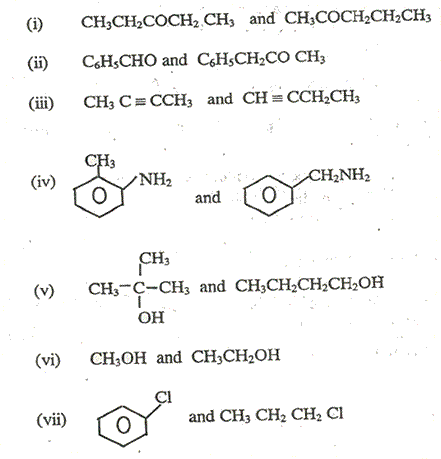PAPER 1
SECTION A
Answer all questions from this section.
1.(a)Determine the oxidation number of
(i)nitrogen in HNO3
…………………………………………………………………………………………………………………………………………………………………………………………………….
(ii)sulphur in S2O8
…………………………………………………………………………………………………………………………………………………………………………………………………….
(b) Write half equation for the conversion of S2O82- to SO42- ion
…………………………………………………………………………………………………………………………………………………………………………………………………….
(c) complete the following and balance the equations
![]()
![]()
2. The stanard electrode potentials E0 of lead en magnesium are shown below:

(a) write the cell conversion for the cell that can be formed
…………………………………………………………………………………………………………………………………………………………………………………………………….
(b) write the equation for the
(i) reaction taking place at each electrode
…………………………………………………………………………………………………………………………………………………………………………………………………….
(ii)overall reaction
…………………………………………………………………………………………………………………………………………………………………………………………………….
(c) Calculate the e.m.f of the cell
…………………………………………………………………………………………………………………………………………………………………………………………………….
3. Complete the following equations and in each case write a mechanism for the reaction
![]()
…………………………………………………………………………………………………………………………………………………………………………………………………….
![]()
…………………………………………………………………………………………………………………………………………………………………………………………………….
4. 1.455g of a compound Y was dissolved in 80g of ethanol. The boiling point of the solution was 78.970C while that of pure ethanol was 78.80C(Kb for ethanol is 1.150C for 1 mol in 1000g).
Calculate the molecular mass of Y in ethanol
…………………………………………………………………………………………………………………………………………………………………………………………………….
5. (a)Methane reacts with chlorine in the presence of sunlight to form chloromethane. Write equations for the reaction and outline a mechanism for the reaction
…………………………………………………………………………………………………………………………………………………………………………………………………….
(b)Some bond energies are given below
Bond Energy/kj mol-1
Cl-Cl 242
C-H 435
Cl-H 431
C-Cl 339
Determine the enthalpy change for the reaction in (a)
…………………………………………………………………………………………………………………………………………………………………………………………………….
6. State the conditions and write equations for the reaction between hydrogen peroxide and
(a) iron(II) ions
…………………………………………………………………………………………………………………………………………………………………………………………………….
(b)iron(III) ions
…………………………………………………………………………………………………………………………………………………………………………………………………….
(c) iodide ions
…………………………………………………………………………………………………………………………………………………………………………………………………….
7. Write equations to show how the following compounds can be synthesized

…………………………………………………………………………………………………………………………………………………………………………………………………….
(b) CH3CO2H (from ethane)
…………………………………………………………………………………………………………………………………………………………………………………………………….
8.The table below shows how the initial rate of the reaction
![]()
Varies with different starting concentrations of X and Y.
|
(X)mol |
(Y)mol |
Initial rate mol sec-1 |
|
0.200 |
0.200 |
4.0x10-5 |
|
0.200 |
0.400 |
4.0x10-5 |
|
0.400 |
0.200 |
4.0x10-5 |
(a)Determine the order of the reaction with respect to
(i)X………………………………………………………………
(ii)Y………………………………………………………………
(b)Write the rate equation for the reaction
…………………………………………………………………………………………………………………………………………………………………………………………………….
(C) calculate the
(i)rate constant
…………………………………………………………………………………………………………………………………………………………………………………………………….
(ii) the rate of the reaction when(X)=0.100M and (Y)=0.200M
…………………………………………………………………………………………………………………………………………………………………………………………………….
9. lithium is in group 1 and magnesium is in group11 of the periodic table but the two elements show some common chemical properties.
(a) State the name given to this type of relationship
…………………………………………………………………………………………………………………………………………………………………………………………………….
(b)Give four examples of properties in which the two elements show similarities
…………………………………………………………………………………………………………………………………………………………………………………………………….
(c) Name two other pairs of elements that show similar type of relation as lithium and magnesium
…………………………………………………………………………………………………………………………………………………………………………………………………….
SECTION B
Answer six questions from this section
10.(a)What is meant by bond energy?
…………………………………………………………………………………………………………………………………………………………………………………………………….
(b) Figure 1 represents the energy diagram for the formation of methane
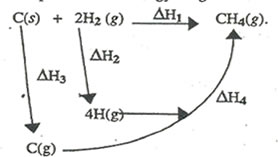
Identify the following energy changes
∆H1……………………………………………………………..
∆H2……………………………………………………………….
∆H3………………………………………………………………..
(c)Given that ∆H1=-75kj/mole
∆H2=+218kj/mole of hydrogen atom
∆H3=+715kj/mole
Calculate the value of:
(i) ∆H4
…………………………………………………………………………………………………………………………………………………………………………………………………….
(i)the bond energy for C-H bond
…………………………………………………………………………………………………………………………………………………………………………………………………….
11.(a)Chromium(III) sulphate was dissolved in water and a few drops of concentrated sodium carbonate solution added to the solution
(i)State what was observed
…………………………………………………………………………………………………………………………………………………………………………………………………….
(ii)Give a reason for your answer and write equations for the reaction
…………………………………………………………………………………………………………………………………………………………………………………………………….
(b)Potassium chromate was dissolved in water. State the shape of the chromate ion
…………………………………………………………………………………………………………………………………………………………………………………………………….
(c)To the solution in (b) was added a few drops of dilute sulphuric acid followed by aqueous sodium hydroxide dropwise until in excess
(i)State what was observed
…………………………………………………………………………………………………………………………………………………………………………………………………….
(ii)write equations for the reactions that took place
…………………………………………………………………………………………………………………………………………………………………………………………………….
12. A buffer solution of pH 4.5 was prepared from ethanoic acid (Ka=1.8x10-5) and sodiumethanoate. The concentration of sodium ethanoate was0.2 mole litre-1
(a) (i) write equation for the reaction that can take place on addition of a small amount of the following to the solution
Dilute hydrochloric acid
…………………………………………………………………………………………………………………………………………………………………………………………………….
Dilute sodium hydroxide
…………………………………………………………………………………………………………………………………………………………………………………………………….
(ii) Calculate the concentration of ethanoic acid in the buffer solution
…………………………………………………………………………………………………………………………………………………………………………………………………….
(b)The graph below shows the pH changes during an acid base titration
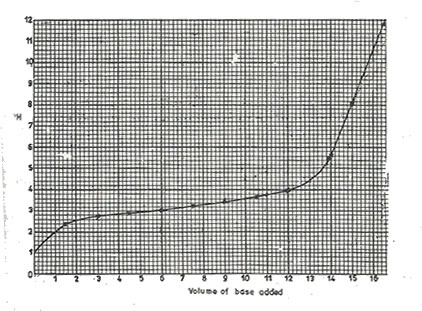
(i)State whether the acid and the base are strong or weak electrolytes
…………………………………………………………………………………………………………………………………………………………………………………………………….
(ii)Determine the pH and volume of the base used at neutralisation point
…………………………………………………………………………………………………………………………………………………………………………………………………….
13. (a) Write an expression for the
(i) acid dissociation constant, Ka for ethanoic avid
…………………………………………………………………………………………………………………………………………………………………………………………………….
(ii) Relationship between acid dissociation, Ka and the degree of ionisation of an acid,α
…………………………………………………………………………………………………………………………………………………………………………………………………….
(b)The electrolyte conductivity of a 1.6x10-2M CH3COOH:200C is 1.96x10-2S m-1 and its molar conductivity at infinite dilution is 3.5x10-2S m2 mol-1
Calculate
(i)the molar conductivity of the ethanoic acid at 200C
…………………………………………………………………………………………………………………………………………………………………………………………………….
(ii)the degree of ionisation of the acid at200C
…………………………………………………………………………………………………………………………………………………………………………………………………….
(iii)the pH of the acid
…………………………………………………………………………………………………………………………………………………………………………………………………….
(c) Besides concentration, state one other factor that can affect the pH of the acid
…………………………………………………………………………………………………………………………………………………………………………………………………….
14.2-bromo-2-methylpropane reacts with aqueous sodium hydroxide to form 2-methylpropane-2-ol
(a)Write the rate equation for the reaction
…………………………………………………………………………………………………………………………………………………………………………………………………….
(b)Draw the energy diagram for the reaction
…………………………………………………………………………………………………………………………………………………………………………………………………….
(c)Write a mechanism for the reaction
…………………………………………………………………………………………………………………………………………………………………………………………………….
(d) State the
(i) rate determining step of the reaction
…………………………………………………………………………………………………………………………………………………………………………………………………….
(ii) technique which was used to study the reaction
…………………………………………………………………………………………………………………………………………………………………………………………………….
15. A compound B has an empirical formula of C3H6O.oxygen gas diffuses 1.345times faster than B.
(a) (i)Determine the molecular formula of B
(O=16)
…………………………………………………………………………………………………………………………………………………………………………………………………….
(ii)Write the structural formulae of all the possible isomers of B
…………………………………………………………………………………………………………………………………………………………………………………………………….
(iii)B has no effect on silver nitrate in ammonia. identify B
…………………………………………………………………………………………………………………………………………………………………………………………………….
(b) (i)using equations, show how B can be formed from propene
…………………………………………………………………………………………………………………………………………………………………………………………………….
(ii) Write an equation for the reaction of B with sodium hydrogen sulphite write mechanism
…………………………………………………………………………………………………………………………………………………………………………………………………….
16. (a) The molecular formula of a hydrocarbon X is C4H8.
Write the names and molecular formulae of all the possible isomers of X
…………………………………………………………………………………………………………………………………………………………………………………………………….
(b) Ozonolysis of X followed by hydrolysis gave only one compound identify the compound
…………………………………………………………………………………………………………………………………………………………………………………………………….
(c) Write equation to show how X can be converted to an alkyne. Your answer should include the conditions for the reaction
…………………………………………………………………………………………………………………………………………………………………………………………………….
(d)Write the name and structural formula of an alkyl halide which can be used as a starting material for the synthesis of X
…………………………………………………………………………………………………………………………………………………………………………………………………….
17. Figure 2 is a phase diagram for a certain substance.
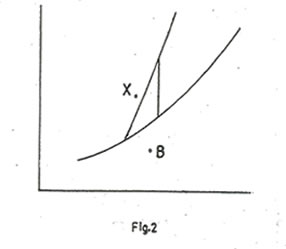
(a) label the following on the diagram
(i) the axes,
(ii) the phases present,
(iii) the critical temperature,
(iv) the triple point,
(b) Define the terms
(i) critical point
…………………………………………………………………………………………………………………………………………………………………………………………………….
(ii) triple point
…………………………………………………………………………………………………………………………………………………………………………………………………….
(c) Explain what would happen when the substance in point X changes to point B
…………………………………………………………………………………………………………………………………………………………………………………………………….
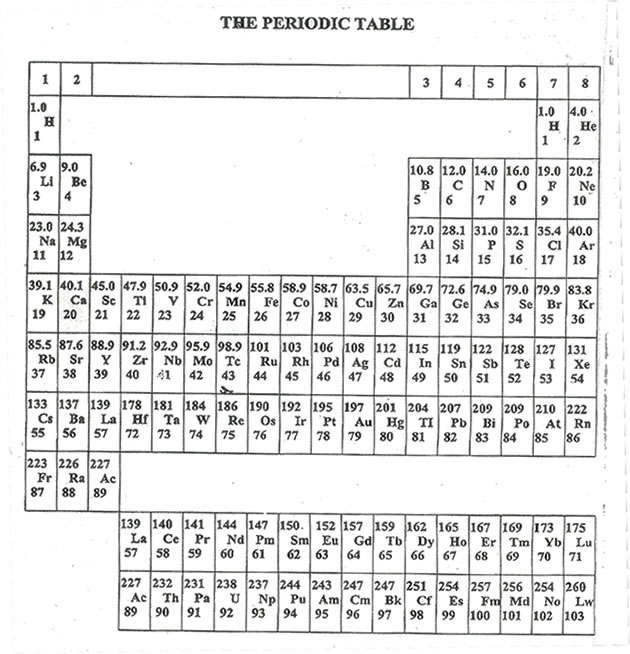

PAPER 2
SECTIONA
Answer three questions from this section
1. (a)The first eight ionization energies of an element B are shown below
Ionization energies / kj mol-1
|
1st |
2nd |
3rd |
4th |
5th |
6th |
7th |
8th |
|
786 |
1580 |
3230 |
4360 |
16000 |
20000 |
23600 |
29100 |
(i)Explain what is meant by the term First ionization energy
(ii)State factors that determine the value of the first ionization energy
(iii)To which group in the periodic table does element B belong?
Give a reason for your answer.
(b)Explain what is meant by the term electro negativity.
(ii) State factors that determine the value of electro negativity of an element.
(c) Explain how the following factors affect the value of electro negativity of an element
(i)atomic radius
(ii)nuclear charge
(iii)the screening effect of he inner electrons
(d)Explain the difference between electro negativity and electron affinity
2. (a) (i)Explain the term Colligative property.
(ii)State four colligative properties of a solution
(b) (i) Describe how the molecular mass of a substance can be determined using the depression of freezing point method.
(ii) State two limitations of this method.
(c) (i) Calculate the boiling point of an aqueous solution of Urea, CO(NH2)2 of concentration 12.0g dm-3 at a pressure of 101.3kPa.assume that the volume of the solute is negligible compared to that of the solution.(the boiling point elevation constant for water=0.520C mol-1kg-1,C=12,H=1,O=16,N=14)
(d) (i) Explain the term mole fraction.
(ii)Calculate the mole fraction 10g of sodium chloride per 100g of water (Na=23.0,Cl=35.5)
3. Write equations to show the reaction that can take place between the following pairs of compounds and indicate mechanisms for the reactions.
(a) but-2-ene and hydrogen chloride,
(b) ethene and iodine.
(c) methylbenzene and chlorine in the presence of sunlight.
(d) benzene and propene
(e) cyclohexanone and hydroxylamine in the presence of an acid.
4.(a)Describe how sulphuric acid can be manufactured from iron(II)disulphide (iron pyrites)
(b) Outline how iron can be extracted from iron(III)oxide.
SECTION B
Answer two questions from this section
5. (a) Heptane and octane form an ideal solution.
(i)State Raonit`s law
(ii)Explain what is meant by an ideal solution?
(iii)Calculate the vapour pressure of a solution containing 50g heptanes and 38g of octane at 200C.(H=1,C=12).
The vapour pressure of heptanes at 200C=473.2Pa
The vapour pressure of octane at200C=139.8Pa
(b) Compound A (bp 3720C) and compound B (bp 3990C) form an ideal solution.
(i) Sketch a labeled boiling/ composition diagram for the mixture
(ii) Using the diagram describe and explain how pure B can be obtained from a mixture containing 50%B.
6. Write notes on the following
(Your answer should include suitable examples and mechanisms for reactions in each case.)
(a) Elimination reaction,
(b) Electrophonic substitution reaction
(c) Electrophonic addition reaction
7. The elements Be, Mg, Ca, Sr, Ba are in group 11 of the periodic table.
(a) Explain how the following factors vary within the group:
(i) atomic radius
(ii) ionization energy
(iii)electropositivity
(b) Beryllium like aluminium can react with sodium hydroxide solution other group11 elements do not.
(i)Write ionic equations for the reactions of beryllium and aluminium with a solution of sodium do not hydroxide.
(ii)List three other properties in which beryllium shows similarity to aluminium.
(iii) Explain why beryllium behaves differently from the other Group-II elements.
(iv)Name two other elements which have similar relationships like beryllium and aluminium.
8. Name a reagent that can used to distinguish between each of the following pairs of compounds. In each case state what is observed when the reagent named is used.
